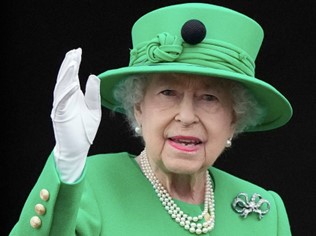Guest: Putting the Crown to Rest

Late British monarch Queen Elizabeth II. Photo: NDTV.
It was fifth period when I heard the news. At 1:31 p.m. on Sept. 8, 2022, it was announced: Queen Elizabeth II’s reign had ended. At 1:32, Wikipedia changed “is” to “was” on her page. Obviously, the response to her death has been varied.
It is especially conflicting for me, my dad being British. I was not raised, by any means, in a pro-monarchist household; in fact, I was taught of the terrible actions of Britain in its colonies long before they graced our textbooks. My dad always thought it was best we learn about our past to make sure we don’t make the same mistakes.
However, the one thing we varied on was our response to Queen Elizabeth II, both in life and death. It is difficult to mourn a woman whose legacy involved the exploitation and violence of various countries. It is, however, easy to miss the brightly dressed woman who posed as a rock for the British people among trying times. Unfortunately, both happen to be named Queen Elizabeth II, thus making the varied reactions to the news understandable.
A royal.uk piece titled The Queen’s Life and Reign praised Queen Elizabeth, saying she had a “sense of duty and…devotion to a life of service, and was an important figurehead for the UK and the Commonwealth during times of both crisis and celebration.” Queen Elizabeth II ruled for over 70 years, having been served by 15 Prime Ministers, starting with Winston Churchill in 1952. She also supported over 500 charities and performed as Head of the Armed Forces, even famously being an ambulance driver in WWII with the ability to fix a car. While all of this is true, it does leave several large gaps in the story.
A Sept. 10 article in The Guardian discussed how the “Queen’s death intensifies criticism of British empire’s violent atrocities.” Quite the catchy headline. There were many examples of why people around the world found no pity or sympathy in their hearts for the passing of the Queen of England.
For instance, just months after Elizabeth’s ascension to the throne, “British colonial authorities in Kenya suppressed a rebellion against the colonial regime known as Mau Mau,” according to The Guardian article. This ultimately led to “the establishment of a vast system of detention camps and the torture, rape, castration and killing of tens of thousands of people,” and “the British government eventually paid £20 million in a lawsuit by Kenyan survivors.” In honor of the Kenyans and many others with similar stories who died in slavery at the hands of the crown that once rested upon Elizabeth’s head, it is reasonable why so many say nothing when they hear of her passing.
Additionally, there is another layer to the mixed reactions. A Sept. 15 article by NZ Herald reported that Queen Elizabeth II’s funeral is to cost over $10 million and will be funded by UK taxpayers. This is during one of the biggest energy crises the country has ever seen, with an 80% spike in energy bills. Nearly a quarter of UK adults plan to keep heating off this winter, according to an Aug. 28 article from The Guardian. This may result in sickness and even death in some cases. It is unreasonable to charge people struggling to heat their homes for a flashy funeral.
Of course, the memes, GIFs and Twitter dialogue began almost as soon as the news was released. There is a variety, from memes that express sadness at her passing (the words “Goodbye Queen Elizabeth” over a saluting cat) to those that hold nothing back (such as one of Queen Elizabeth II being smashed with a stop sign called Death). I don’t think that they should be censored, because let’s face it, memes are our generation’s way of dealing with historical moments. I personally do not look up the memes, more out of respect for my dad than anything. He understands that royalty, and by extension Elizabeth, have done terrible things, but he mourns the Queen Elizabeth that he remembers. The one that gave a speech every Christmas time, had two beloved corgis and was the spirit of Britain. And just as I respect him, he respects my inability to find true sadness at her death. It’s a balance as we all try to understand our feelings toward such a multifaceted figure head.
There is a lot to say about how Queen Elizabeth II encompasses the tradition of Britain, arguably as much as a tourist attraction like Big Ben does. There is a lot to be said about how she was often an icon for UK residents to look toward in troubling times. It cannot be forgotten, the love many citizens felt for her (just look at the 30 hour and multiple mile long line wait just to see her coffin) as well as the unification she provided.
And it cannot go without mentioning that all I have written has been from an American perspective. She was never my queen, therefore I have very little of the emotional connection that most British people do. But it cannot be ignored how much of her reign meant terror and horror for her subjects both in and out of the British Isles, and how the crown on her head reflects a history of colonialism and genocide, as well as pompousness and ostentatiousness. Queen Elizabeth II’s reign ending is also the closing of an era, possibly the final chapter of the monarchy. Perhaps finally, after much bloodshed and controversy, the crown may finally be put to rest as the relic of the past that it is.





